#phylogenic trees
Text
Tired of interacting with media in a normal way
9 notes
·
View notes
Text
i fucking love buttons
#in an autistic way. im going to make a phylogenic tree about these bitches#i go to antique stores garage sales etc and buy big bags or jars of buttons#my heart is filled with joy to see them
1 note
·
View note
Text
What Is and Isn't a Fish: an Essay and Guide by Fishyfishyfishtimes
A simplified list of the animals I discuss can be found here!
Hello folks! I created this post to have a kind of definitive essay/explanation of what is and isn't a "fish", starting with defining the term and going over animals that fit and don't fit the bill. As other fishblr artists, writers and educators must know too well, some people are confused about where this term begins and ends, mistaking other aquatic animals for fish. I have my fair share of arthropods and cnidarians as fish fact requests in my own askbox, heck, some years back a friend of mine asked me if clams were fish. The event that finally made me decide to write this was someone requesting that a fish-only account draw a crustacean, pondering to themselves if they count as fish.
I don't want to hold it against these people. It's impossible to know something when you've never been taught! So that's what I'm here to do, hopefully achieving a pretty correct and universal view ^^' If I make any mistakes please correct me. I'm learning all the same as everyone else is.
Definition of fish
Immediately, we run into a bit of a problem with the definition of fish. See, what the term "fish" means has fluctuated for centuries! For a long time, pretty much any animal that lived in water was a "fish" — I say "pretty much any" instead of "every" animal because for a long time sessile animals like sponges or corals were thought to be plants. This is why we have such remnants in our language like shellFISH, starFISH and jellyFISH, they lived in water so they were called such!
Occasionally these definitions would be changed for cultural convenience too. Many Christian churches take part in Lent, and in the Catholic church red and white meat is forbidden on Fridays and Ash Wednesday. In the Middle Ages, in my own country, Finland, this abstinence of red and white meat could last up to 140 days! To make fasting easier, many animals were labelled fish for convenience so they could be eaten as well. These newfound "fish" included seals, beavers and swans, pretty much just anything that was aquatic or semiaquatic in nature.
Nowadays just going off of looks or behaviour won't do, though. There has been much more of an effort to define fishes coherently based on their anatomy and phylogeny, which is great! Problem is, that's easier said than done: fishes are an extremely diverse group, and uh.. not really a single group, either. I'll show you:

As you can see from this heavily simplified phylogenic tree, fishes are not a singular group like, say, mammals are! The animals that we group under "fish" are actually a part of several distinct lineages of animals, some more closely related to us than each other. Heck, tetrapods, which include amphibians, reptiles*, and mammals, are fish themselves! Phylogenetically speaking. Our ancestors were lobe-finned fish, and, well, you never stop being the previous taxon even when you evolve into something else. If you try to exclude tetrapods, no such unified group as "fish" exists. Still, when discussing fish, we tend to want to avoid talking about every vertebrate ever and instead focus on the very specific aquatic ones we mean when we say "fish". This is why many definitions of the term "fish" still exclude tetrapods, even if we share a common fishy ancestor. "Fish" describes more of a lifeform than it does a clade, much like the term "worm"!
(*birds are reptiles! This could be a whole post in and of itself, but I'm not here to write about that. Someone else has most likely taken up the task!)
Hooray, it's definition time! As stated previously, fishes are an extremely diverse group of thousands of species, and what terms might apply to the Atlantic cod may not apply to the yellowfin tuna or giant mudskipper, let alone a Pacific lamprey! Encyclopedia.com defines a fish as "an ectothermic chordate that lives primarily in water and possesses a cranium*, gills that are useful virtually throughout life, and appendages (if present) in the form of fins". Encyclopedia Britannica notes that "the term fish is applied to a variety of vertebrates of several evolutionary lines", instead highlighting five classes. These five classes are left partly unspecified, but ones that are mentioned are jawless fish, cartilaginous fish and bony fish (which still includes tetrapods, however), and the two classes left can be assumed to be two classes of extinct fish. Wikipedia defines a fish as "an aquatic, craniate**, gill-bearing animal that lacks limbs with digits". Tim M. Berra, an academy professor and ichtyologist, defines fish as "poikilothermic***, aquatic chordate with appendages (when present) developed as fins, whose chief respiratory organs are gills and whose body is usually covered with scales".
(*cranium=upper part of the skull **craniate=an animal with a skull ***poikilothermic=an animal whose internal temperature varies considerably)
From these more or less detailed definitions we can gather many defining features for fish: a cranium-having chordate, primarily aquatic, gill-bearing and uses gills as their main respiratory organ, lacking any limbs with digits, instead having their limbs be in paired and unpaired fins when present. Most fish are also ectothermic, meaning their body temperature is determined by their environment, but some can heat up parts of their body or their entire body in the case of the opah. Most fish also have scales, but not all, just like how most fish are fully aquatic, but some like lungfish or mudskippers can spend considerable time out of the water. Such is the way of these magnificent and diverse animals!
Finally, with all this out of the way, we can get into...
What is a fish!
Here, I will be detailing animals that are fish! Well, at least the broadest strokes; there are more than 30 000 fish species and if I listed them all we'd be here all life. I shall instead go over the major classes and list, in short, some groups that belong in them.
Jawless fish (Superclass Cyclostomi)
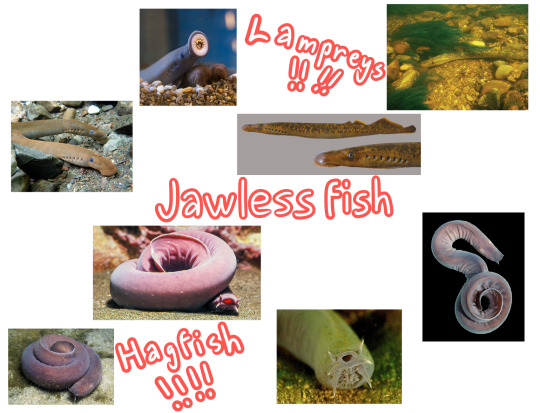
Jawless fish are often a topic of debate, especially in matters of their relation to each other and to jawed vertebrates. Evidence seems to point to hagfish and lampreys being closest related to one another and to lampreys being more closely related to jawed vertebrates than to hagfish (which would make hagfish craniates but not vertebrates). In the phylogeny tree above I decided to portray hagfish and lampreys as a monophyletic group, as molecular studies and microRNA analysis seems to point to a monophylegic superclass. Please note that this could go either way, though.
Jawless fish is a group containing two extant fishes, hagfish (class Myxini) and lampreys (order Petromyzontiformes)! Jawless fish are more "primitive" than other groups, for example both lack true vertebrae and scales. Still, they both have craniums and gills and they are aquatic, and so they have earned their place among fish!
Cartilaginous fish (class Chondrichthyes)
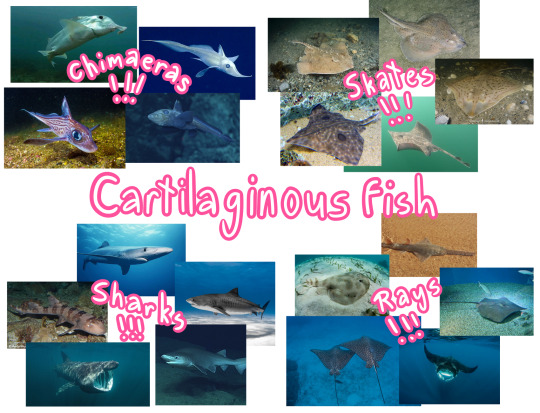
Surprisingly, I've found that this group has a lot of confusion surrounding it. I have received many a request confirming if sharks are fish, or asking if I'd cover a shark "even if it's not a fish". So I'll say it now: good news, sharks are indeed fish! So are their cousins, rays, skates and chimaeras, also known as ghost sharks! All of these fish have a primarily cartilaginous skeleton, tooth-like dermal denticles and lack gill covers and a swim bladder. Out of all the sharks, I also want to highlight that the whale shark, despite its confusing name, is a shark and not a whale. So, it is a fish!
Ray-finned fish (class Actinopterygii)
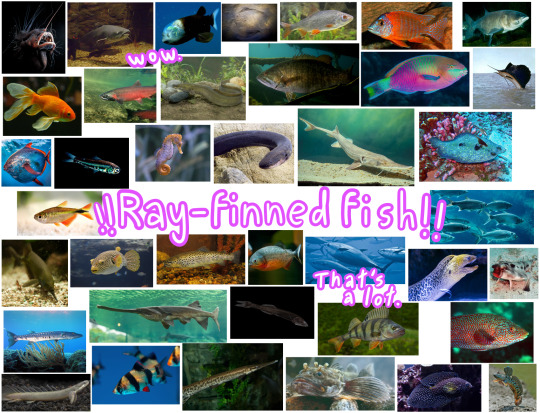
Name any fish, and there's a 96% chance the species name you said belongs to a ray-finned fish. Unless, like, you really like sharks. But this isn't about them.
Ray-finned fish are the biggest group of fish and incredibly diverse! It has your seahorse, your pufferfish, your bass, your tuna, your anglerfish, your clownfish, your salmon, your sturgeon, your lanternfish, your perch, your oarfish, your gar, your sardine, your moray eel... and this is only a tiny, tiny fraction of the groups that belong to this class! Defining features of ray-finned fish are that they tend to have a swim bladder and a bony skeleton (some exceptions though. Sturgeons, for one, have evolved a cartilaginous skeleton but they're still ray-finned fish). The largest group of ray-fins, the teleosts, also have leptoid scales, which are thinner and more flexible and grow with growth rings.
I want to bring special attention to some members of the ray-finned fish which tend to have a lot of confusion surrounding them and their heritage: eels and seahorses. Many people think these two are not fish due to their strange anatomy, like lack of scales or (many) fins and their elongated bodies, and I wouldn't blame them! Seahorses belong to family Syngnathidae, which also includes seadragons and pipefish. Eels, meanwhile, make up the order Anguilliformes. All of these long friends of ours are fish!
Lobe-finned fish (clade Sarcopterygii)

I shall merely focus on the fishy fishy fish individuals of this class, which excludes tetrapods. Lobe-finned fish house the two extant species of coelacanths, and six extant species of lungfish! These fish are bony and their fins are placed at the tips of fleshy, lobelike stalks, resembling the limbs of tetrapods. It is thought that the common ancestor of coelacanths and lungfish and tetrapods had similar structures that then became the four limbs the members of our clade typically have. Coelacanths and lungfish are wonderful fishes and deserve a lot of love and respect, not only because they're our closest cousins but because they're unique and we have so much to learn about them!
So, these are the fishes! There are also extinct groups of fish, namely class Placodermi (armoured fish) and class Acanthodii (spiny "sharks"). I'm moreso an extant fish account however, and so I shall move onto...
What isn't a fish?
Now we get into the real meat of this post. Without further ado, here are some aquatic friends of ours that can be mixed up with fish very often!
Crustaceans (subphylum Crustacea)
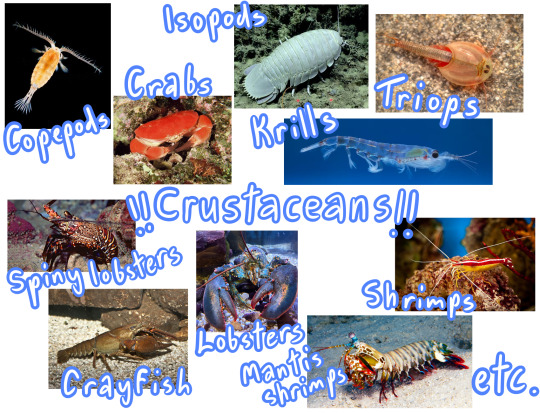
Many of our hard-shelled many-legged friends belong here! Crabs, lobsters, crayfish, shrimp, krill, isopods, triops, barnacles, copepods, you name it! Even though many crustaceans are aquatic or semiaquatic and have gills, you'll find that they're invertebrates that lack an internal skeleton (so no cranium, not even vertebrae)! We still love them though!
Mollusks (phylum Mollusca)

Creatures both soft and hard-shelled! Cephalopods like octopuses, squid, nautilus and cuttlefish, bivalves like clams, mussels, oysters or scallops, gastropods like sea slugs and snails and chitons go here! These friends of ours are also aquatic and have gills, some even have the suffix -fish (cephalopods used to be called inkfish, even!), but their lack of an endoskeleton is even more obvious than the crustaceans'. They're invertebrates, and therefore not fish!
Chelicerates (subphylum Chelicerata)
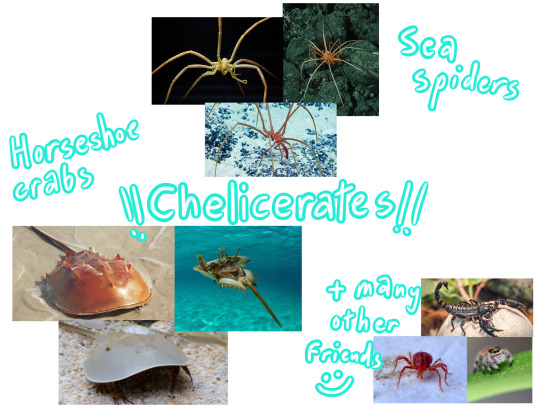
This group has many animals that are very hard to mistake for fish, namely spiders and scorpions, but horseshoe crabs and sea spiders are two groups of extant marine chelicerates! Both groups are aquatic, and horseshoe crabs have gills. However, they're both invertebrates, lacking a cranium or vertebrae. Other aquatic chelicerates exist, but they're usually very small, like water mites.
Cnidarians (phylum Cnidaria)

This phylum has the sessile corals and sea anemones and the usually more mobile jellyfish and siphonophores (includes the infamous Portugese man o' war!). I imagine corals and sea anemones are mistaken for fish less due to their sessile nature, but they're good to bring up nevertheless. None of these animals have a backbone, or, any bones really. They lack gills, they lack fins, they even lack the bilateral shape of fish. Jellyfish, despite the name, are indeed not fish! Some people suggest the name sea jellies be used for them instead, and I think it's much cuter.
Echinoderms (phylum Echinodermata)

Animals like starfish, sea urchins, brittle stars, sand dollars, sea cucumbers and feather stars go here. It seems that this pesky "-fish" -suffix is hard to shake off, as now we have the starfish. Once again, all of these slow-moving bottom-dwelling friends of ours are invertebrates, as they lack vertebrae or a cranium. Interestingly though, they are among our closest invertebrate relatives! So we ought to give them some props for that. I also want to mention that starfish can also be called sea stars, which ought to lessen confusion about their being too.
Comb jellies (phylum Ctenophora)

Comb jellies look a lot like jellyfish, but they belong in their own unique phylum! They have the same deal going on; they are invertebrates, they lack gills, they lack a cranium, they are simply aquatic.
Lancelets (subphylum Cephalocordata) and tunicates (subphylum Tunicata)
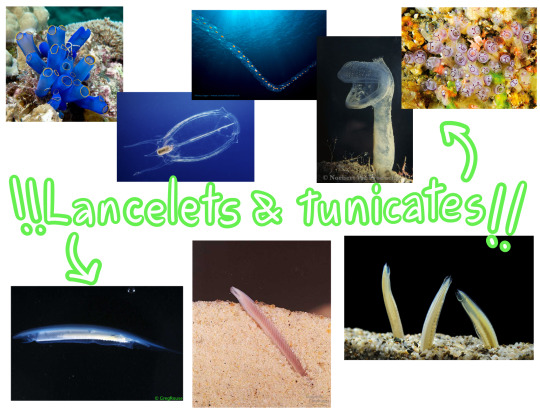
A double feature, because I wanted to save space didn't want these guys to be all alone! Lancelets and Tunicates, like sea squirts and salps, are chordates, which you can find in the phylogenic tree I drew all the way in the definitions section. They share many a feature with vertebrates, like a bilateral bodyplan, a notochord at some stage of life and a post-anal tail, but I'm afraid they're still not fish. They lack a cranium and their notochord does not develop into a vertebral column! Sorry friends, you tried. We can still hang out at the chordate convention.
Annelids (phylum Annelida)

The infamous bobbit worm, bone-eating worms, sea mice, giant tube worms, feather duster worms, spoon worms, bristleworms in general, leeches... many, many worms go here! Pretty self-explanatory: they are invertebrates, even when they live in water. They're extremely cool invertebrates too! I suggest taking a look at some of them, there's many interesting species.
Flatworms (phylum Platyhelminthes)

Flatworms are another very diverse group of worms, having many species both terrestrial and aquatic, however mostly I want to put attention into the free-swimming marine flatworms. They may swim beautifully (and fence with grace), but they are nevertheless invertebrates! Flatworms can live a variety of different lifestyles, from predators to parasites.
Amphibians (class Amphibia)

We've made it into vertebrates now! Amphibians include frogs, salamanders, and caecilians. While they have limbs with digits in their adulthood*, they can be easily confused for fish in their larval stages! This is no surprise, as they use gills to breathe underwater and tadpoles lack any limbs at all for a while. Many amphibians later transition into a terrestrial or semiaquatic way of life and lose their gills, not to mention gain their digit-having limbs.
(*excluding caecilians)
...Well, many amphibians do this, but not all. It's important to mention there are also species of aquatic salamanders which can bear great resemblance to fish with their elongated bodies! Amphiumas, which are sometimes mistakenly called "conger eels" (which is an actual species of fish), are aquatic salamanders with small residual limbs and both working gills and lungs. Giant salamanders and mudpuppies/waterdogs have lungs and gills as well, and lead an aquatic lifestyle — olms are close relatives of mudpuppies. Sirens, meanwhile, lack hind limbs and only have small front limbs, along with retaining their gills in adulthood. Among aquatic salamanders I also want to bring up one most often talked about species: the axolotl! They remain in their larval form, have external gills and lead an aquatic lifestyle. It can be hard to tell with aquatic salamanders sometimes, but these friends of ours are amphibians and not fish, even if they've rejected the land life.
Caecilians are a bit less known overall, but they can also cause a lot of confusion due to their long, limbless body. While most caecilians live underground, some are aquatic in nature, and can therefore be mistaken for fish! However, caecilians breathe via the use of their lungs and through the skin and don't have any gills at all.
Reptiles (class Reptilia)

Most commonly mistaken for fish in this group are sea snakes, sea kraits and water snakes, sea turtles, turtles, penguins, and other (semi)aquatic birds. Sea snakes and water snakes bear a very strong resemblance to eels, but they are indeed just snakes adapted to an aquatic or a semiaquatic lifestyle! The same goes for sea turtles, turtles overall, and penguins. They all need to breathe air and they lack fins, even if their flippers, webbed feet and built-in paddles may look like fins! They also have wholly different types of scales (or feathers!!) than what fish have, even if they share the feature. I assume that other aquatic reptiles, like the marine iguana and crocodilians are better read as reptiles thanks to their limbs with digits, but I want to give them a reptile shoutout anyway. They’re aquatic or semiaquatic, but they are air-breathers and fin-lackers all the same!
I also want to mention one specific extinct group of reptiles, ichtyosaurs! These marine reptiles were rather shark- or dolphin-like in appearance, which is actually a really good example of convergent evolution! Like all other reptiles, they also needed to breathe air and they had... erm... well, I'm not sure if I can call the bones in their flippers digits, but, that's what they used to be, so...? They were cool reptiles and among my favourites! There were many other aquatic reptiles too, but I will only mention just the ones now. A paleontology account would be better-suited to list you allll the marine reptiles.
Mammals (class Mammalia)

Our home class! Some of the aquatic friends we have in this class include whales like baleen and beaked whales, dolphins (orcas go here), porpoises, belugas, narwhals and sperm whales, pinnipeds like seals, sea lions, walruses, and sirenians like manatees, (occasionally known as sea cows) and dugongs! We also have some semiaquatic buddies like hippopotamids, otters, beavers and platypuses! Whales and pinnipeds especially often cause a lot of confusion due to their very streamlined, fishy appearance. They are, however, air breathers that feed their young with milk (some dolphin calves are even born with some hair), and their ancestors were land mammals! The same goes for pinnipeds and sirenians too. True seals, fur seals and sea lions still have fur even! Hippos, otters, beavers and platypuses are a bit more obvious as mammals with their fur and.. distinct air-breathing.. but I wanted to mention them anyway. Their adaptations to aquatic life are just one example of how fascinating evolution can be!
And here we are! A hopefully comprehensive list of fishes and non-fishes, beginning with the ever-shifting story of the term "fish", phylogeny, and why some animals are called fish when they really aren't. I hope you have found useful and interesting information in this post, and perhaps learned something new! I bid you a farewell! :D
#fish guide#fish essay#fish#fish facts#fishfact#marine biology#biology#zoology#long post#jawless fish#cartilaginous fish#ray-finned fish#lobe-finned fish
255 notes
·
View notes
Note
how do you avoid making a creature that's too similar to another?
Excellant question, because it’s a perfect occasion for me to discuss about diversity, a central theme in this serie, and how to illustrate it !!
The first method is creature design in its purest form : what does my creature looks like ? And then breakdown every aspect of what makes a monster. For anatomy i see 2 main parameters :
architecture : how many limbs ? heads ? and where to put them ? For example you can see “gryphons” as a kind of structure, with 4 legs, 2 wings and a beak (roughly) and play around with this structure
proportions : the same chimera with different proportions makes very different monsters ! You can play with the head/body ratio, make some limbs vestigial, or big wingspan to make them impressive, etc. For chimeras, this is the main difference between drawing and taxidermy !
Another aspect for my case with chimeras is which species i’m using. Unless i have a precise idea in mind i always make some quick research :
for example if i need a flamingo i check all the different kinds of flamingoes on wikipedia ; sometimes i go back up the phylogenic trees to see similar animals but slightly different
if i’m illustrating a monster from a precise geographic location i try to look for local species too, to make it more consistent
sometimes the design is based around a particular specie of animal i find interesting
i guess it goes with species, but you can obviously change patterns (on fur, wings etc) or colors (not my problem tho).
For example, lately i’m drawing Lemures where i combine bodies of lemurs with heads of larvae : the architecture is always the same but the possibilities are endless !
Second method is more concept-driven :
it’s how can i challenge definitions and concepts (whats is a dragon ?? seriously ???), try to explore it and cover all the range of the definitions and push them at their limits (ok now i have no idea what a dragon is anymore)
it can also start with a theme (what if i combine all the animals behind the symbols of the Seven Deadly Sins to make a chimeric representation?? what if that beach i went once 2 years ago were full of creatures ???), and it could be something very abstract (what if that music is actually about a monster ??)
you can also mix concepts together (metachimeras) !!
I also start from prompts (through asks, challenges and shittycryptids, mostly), because there are many ways to interprete them : sometimes i try to channel different inspirations by previous interpretations into one design, sometimes i just give what people wanted to see, but i have more fun when i respond exactly to the prompt in the most unpredictable way.

All of these methods bring a lot of diversity, and i will never run out of ideas ! The possibilities for chimeras are endless, and these are some methods i’ve got to find them. If you have other methods please share them !! And if you are interested by the methodologic aspect, i’ve done a masterpost that explain the tags for different categories and links to check the chimeras behind.
And also, most importantly maybe, but i try to leave some space for intuition : if something works or comes in my mind and it looks good i just go with it ! I always have a sketchbook for when i’ve got random ideas coming to me. Intellectualizing the process is fun, but creation isnt only about methodology.
#and this is only about design i havent talked about artstyle#i feel like that post is unreadable ahaha#ars chimera#ask#themarshmush#chimera#monster#creature design#bestiary
43 notes
·
View notes
Text
Oké guys, turns out i actually love making tournaments, and i don't want to stop now. Would you like one more? If yes, what should be the theme?
47 notes
·
View notes
Note
heya. so, how do you think you would handle Misty meeting either Wimpod/Golisipod or Dewpider/Aquranid in person? Im glad they at least acknowledged it in the Cilan/brock episode of MPM.
Hello!!! That's a great question. I personally think that for Dewpider/Araquanid, the legs would freak her out??? I think they might be a bit TOO spider'y for her. Maybe if Lana or someone put funny socks on all the legs she could be okay with it lol. As for Wimpod and Golisopod, I think she might be okay with them! They're kinda buggy, but they're based on sea creatures so I think that if she's okay with some of the fossil pokemon that are also sea creatures she'd be okay with Wimpod and Golisopod, since they're not far off biologically from, say, Anorith and Armaldo or Omanyte and Omastar. I actually dragged out an old Oceanography textbook I have, and the creatures they're based on are all in a similar clump (intermediate coelom in the simplified phylogenic tree of marine life).
TL:DR, probably okay if she can get used to them!!!
6 notes
·
View notes
Note
i noticed one error with your phylogenic tree of invertebrate pokemon- fomantis and lurantis aren't bugs! they're plants that mimic bugs. their disguises fooled you!
That may be so, but Wo-Chien is a pile of leaves and Iron Moth is a robot! I'm not splitting hairs as long as it's inspired by an invert!
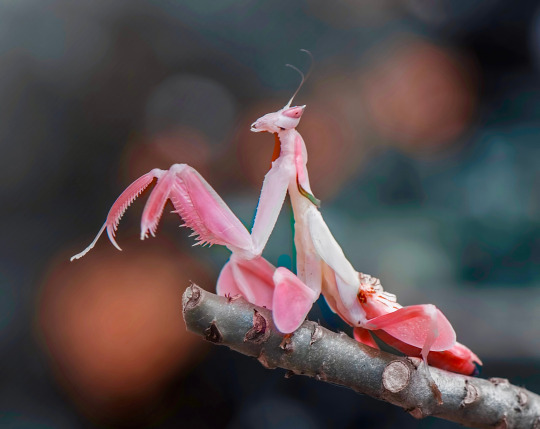
6 notes
·
View notes
Text
Fungus Among Us
I have a mutual that asked me questions about mushrooms. I Love plants and mushrooms, so I decided to do a post about it, because I think other mutuals might also enjoy my mycological ramblings.
But be warned... This subject is one of those things I can go on about for hours and be perfectly entertained despite the abject boredom or terror of those subjected. So out of kindness...
First off, This is a Very big subject, and I strongly recommend use of Wikipedia for a brief overview of literally any big subject, just for familiarization with basic organizational knowledge and vocabulary.
I am going to rehash some of that here, though, because it is fun for me.
To give you an idea of how big a deal the differences are between Fungus and All other kinds of life, understand that they have their own cladistic kingdom (a major group containing similar kinds of life), separate from Plants and Animals.
Fungi range from single celled eukaryotic organisms (Yeast!) (a special kind of cell with distinct features, shared with plants and animals, and different from bacteria) to complex, multicellular organisms (like the Honey Mushroom in Oregon that is over 2300 acres) that are literally some of the largest on the planet. With such diversity of size, they have a number of diverse forms that follow different methods of feeding, breeding and living in their wildly varying environments, on land, in the air we breathe, in the ocean, and far underground. We will not need to go too far into the wild phylogenic weeds here, because the questions that were asked narrow things down a bit.
As Fungi, mushrooms they live most of their life cycle as microscopic colonies of threads (hyphae) in the ground, that can form large networks (mycelial networks) they exist to absorb nutrients. They can get food and water both from their immediate surroundings and by expanding into the cells of plants, to take their nutrients. Many mushrooms have special relationships with plants (symbiosis) that benefit both organisms, and these dominate forest environments.
Everything you think of as a mushroom, with the stalk and cap, or the little wiggly dudes that look like clams that stick out from trees, Those are all sexual structures. These reproductive bodies are specifically to aid in spore dispersal. Also some are very tasty.
If you are lucky, you have some right now. I hope they are morels. Or maybe some big porcinis...
Fungi do definitely live in human tissue. They are in you, and on you, through and through. Candida albicans (Yeast!) is one of the primary fungi that exist in healthy human digestive tracts. There have been cases where people have had inoperable fungal colonies in inconvenient tissues, like their lungs. Thankfully, it is generally better behaved than that, because our immune system keeps it in check.
More after dinner...
@solostinmysea
3 notes
·
View notes
Text
getting the entire phylogenic tree of life tattooed on my back including all the taxonomic information for each entry
2 notes
·
View notes
Text
MUTE SWAN, OCTOBER
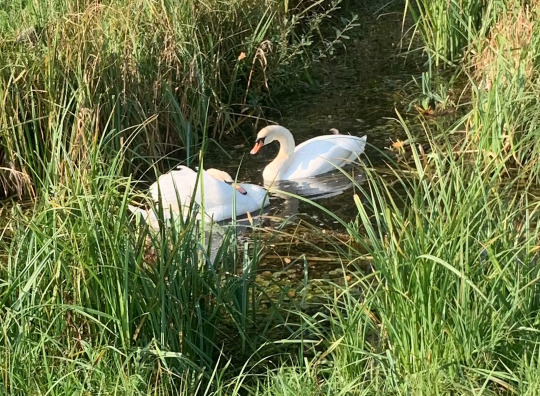
These are famously some of the scariest birds in Britain, the mute swan (Cygnus olor). They’re famous for other reasons too: The British Monarch has the right to ownership of every single unmarked mute swan in Britain, making it an act of treason to kill one! There are also still two swans that live at Bishops Palace in Wells, England that have been trained to ring a bell for their lunch. They are also remarked for their sleek elegance and beauty in the popular Hans Christian Andersen fairy tale ‘The Ugly Duckling’.
In the real world, baby mute swans - known as cygnets - are very cute. They grow very quickly, almost reaching adult size within three months after being hatched, but keep their juvenile feather collar until they are at least one year old. In the photo below you can see their fluffy grey down and grey-black beak, contrasted with the white feathers and orange beak of their parents:
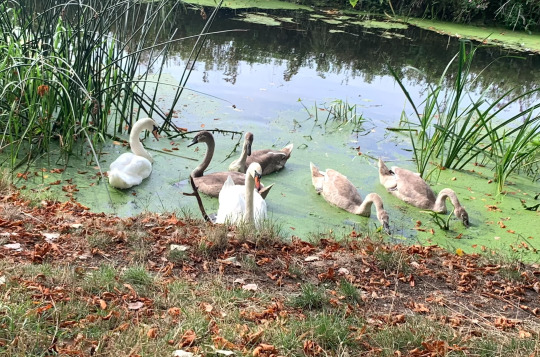
As I said before, their reputation as an elegant but feisty bird is well known. Mute swans are usually highly territorial, and will become very aggressive in defence of their young, hissing loudly and sometimes physically attacking by striking the intruder with the bony spurs of their wings and biting with their large orange bill. A common myth is that the wings of a swan can break a mans leg: while this isn’t true, they are still very strong. Other swans, such as the black swan, are much less aggressive.
There are six species in the genus Cygnus - all known as swans - that live all around the world, usually in temperate climates. Most of them also migrate during the year to breed. The mute swan is known as a ‘partial migrant’ species, being resident in Western Europe but wholly migratory in Eastern Europe and Asia. All of the birds in the Cygnus genus have the trademark long necks, large bodies and webbed feet. Lesser known but also very interesting is the fact they also have a serrated edge to their bills that act like teeth. Below is the Phylogenic Tree for all of the swans:

Mute swans tend to eat aquatic vegetation on the riverbed that their long neck allows them to reach. They will also graze from grassy fields, as well as sometimes eating small fish, frogs worms and molluscs. Their main predator is, besides from maybe humans, the fox. Other threats to the mute swan is freshwater pollution, flying into power lines, and accidentally eating led weights previously used by anglers.
Due to their status as a protected species and ability to migrate, the mute swan is classified as Green in the Birds of Conservation Concern 5: the Red List for Birds. However, it is always good for ecologists to keep tabs on the population sizes and distribution of any bird species. The UEARG (University of East Anglia Ringing Group) have been ringing swans for many years, but only in small numbers. For example, in 2019 only 20 were ringed. However, in 2020, the UEARG began using colour rings instead of metal rings. These have the benefit of being able to give data without catching the bird to read the ring, as the colours can be seen from afar. This also allows the public to aid in the research, by telling the UEARG when and where they see a swan with a certain colour. Within the first 6 months of using the colour rings, they had colour ringed 123 swans across Norwich and amassed over 400 sightings across 17 sites!
To find out more about projects like this taking place right here in Norwich, visit: http://uearg.blogspot.com
0 notes
Text
Inhibitory effect of Adenylosuccinate synthase in selenite-induced cataract inside Sprague Dawley rat puppies
Your Iberian Peninsula carries a lengthy reputation anthropogenic disturbance which includes resulted in poor people conservation reputation of its ichthyofauna, together with Fifty two Per-cent associated with kinds currently listed while really decreasing in numbers, decreasing in numbers or perhaps weak, in accordance with Selleckchem Cisplatin UICN standards. This kind of paper provides an overview of the principle dangers (environment deterioration, hydrological changes and amazing types) which may have changed the part as well as on the web connectivity involving Iberian estuaries and rivers. Case-study examples are offered to evaluate the actual repercussions of such threats as well as the operations activities prepared or perhaps previously carried out of these methods. The particular connection of several risks is liable for local fish fall. Even so, river supervisors and research workers ought not allow trees reduce these coming from Adenylosuccinate synthase seeing the general timber, whenever seeking to accomplish sensible options using the finest healthy expense gain and also the effort of most habitat experts as well as stakeholders. Efficiency initiatives should be dedicated to the preservation of environmental processes, to have the actual ambitions with the Drinking water Framework Information and also guarantee the preservation associated with Iberian native fish species Ibrutinib clinical trial .The actual D termini regarding N-methyl-d-aspartate (NMDA) receptor NR2 subunits are viewed to play a serious part from the molecular institution of storage over the Bilateria, using the trend referred to as long-term potentiation (LTP). Regardless of his or her lengthy history of utilize since versions inside the research regarding storage, your appearance along with structure in the NR2 subunit from the Lophotrochozoa has remained uncategorized. The following, we document the particular phylogenic relationships involving NR subunits throughout the Bilateria, as well as the cloning along with situ analysis of expression regarding NMDA NR1 and also NR2 subunits in the monogont rotifer Brachionus plicatilis. RNA inside situ hybridization suggests term of NMDA receptor subunits within B. plicatilis is neural, consistent with expression seen in additional types, along with ours will be the first statement confirming NR2 expression inside the lophotrochozoan clade. Even so, the one NR2 subunit determined inside N. plicatilis was found in order to lack the extended H critical site found in vertebrates, which can be believed to modulate LTP. Further analysis says mollusc along with annelid NR2 subunits have got lengthy intracellular C terminal internet domain names. Since information through molluscs (especially Aplysia californica) would be the cause of much of our knowledge of LTP, focusing on how these kinds of diverse lophotrochozoan Chemical termini operate inside vivo could have numerous ramifications for how all of us take into account the advancement from the molecular power over learning and also storage over the Metazoa overall and interpret the results regarding studies into this important part of knowledge.Aims: An increasing number of research has shown which ex girlfriend or boyfriend vivo respiratory perfusion (EVLP) is protected which refused contributor voice can be resuscitated as well as useful for respiratory transplantation (LTx). First scientific outcomes in sufferers transplanted along with refurbished voice in each of our heart have been examined and in contrast to those of contemporary non-EVLP controls.
1 note
·
View note
Text
I would love to watch a documentary or recreationally take a course that covers modern music history. Like specifically the technological history from the the MOOG to the drum machine to modern music production software. Has anyone or any group of people done a good job making some kind of phylogenic tree of genres and subgenres plotted on a timeline? I know many genres have varying degrees of documentation regarding their origins but has someone made a good effort to compile them? It wouldn't work like the actual phylogenic tree because many genres exist because two genres cross-contaminated. But that would be fascinating to me. I would love to look at a timeline that could show genres evolving and branching out with short samples and some context for what lead to that evolution (political circumstances, technological advancements, mass immigration, etc.).
I'm listening to a short BBC radio doc about the TR-808, 909, and TB-303 and I'm enthralled and I've been spending a bunch of time reading about the history and relationships of the genres I've been into lately (mostly hardcore/dnb subgenres - breakcore, gabber, hardstyle) and it's so cool. I've always believed it when people have said it but it is actually mindblowing how all the modern genres leaned heavily on influences from jazz, funk, disco, r&b, reggae, and hip-hop during their transformational periods.
#also getting really emotional about this idk what thats about#the fact that I spent all my time in music classes learning about music that existed before the amplifier is stupid#i recognize the value in learning about music composition but i learned shit all about that anyway#don't expect these questions to be answered I'm just bursting at the seams thinking about this and needed to release a bit of the pressure
1 note
·
View note
Note
Hello! I love fish and was wondering if you have a guide to the different groups? Where would I put a mandarinfish vs a sturgeon, and even more species specific? That kind of thing!
I’m afraid I do not! I know there are books on the taxonomic classification and phylogeny of fish and where they’d be classified; I’ve read some myself! However, when I go about looking through where fish would go on the phylogenic tree, I sort of go through that process manually looking it up, I don’t have any specific goldmine of information ^^’ One place to look is fishbase, it tells you what class, order, family and genus a fish belongs in. If someone had any other good sources to share for anon, that would be swell!
7 notes
·
View notes
Text
Gloreal Goals:
Deciding if I’m gonna just keep calling them Gloreals.
Actually show off some doodles of bauplans for them and their ancestors. Outline the castes and geographic subgroups (the Treefolk and their feather-castes— the Plainsfolk and their Height-based castes— Hivefolk— Coastal Mountees—),, include the arboreal superstitions about outsiders (the wind wraiths, coastal zombies and underground fae—- compared to human myths anyway, before they branched out later in their history.)
Keep working on the planet cause it’s kinda equally important to me. Work on the phylogenic tree for the well, IMPORTANT TREES (the trees which fuse together, and were borne of once mixotrophic organisms— they have very distinct layers, in their gigantic forms and their smaller relatives, and are some of the only PreLuna plants still existing). DIFFERENTIATE LUNAR AND POSTLUNAR PLANTS.
Make a geologic timescale which accounts for shifts in tectonic plates and major planetary events (such as the loss of the moon and change in orbit— substantial changes in temperature—).
Work on the calendar. Really. Really want to focus on how they see time and celestial bodies. Given every four years the moon suddenly zooms back into view then slowly retreats—- making all sorts of ancient plants act up—- inducing ‘lunar madness’ (folks were just scared of the moon for a long time)—-
two subtly different shifting orbits means plants as well as animals either adapt to ADAPT— or live *very short lives* compared to the Gloreals (who had long prior been diurnal burrowers, escaping much necessity of the moons appearance as biological imperative).
Diagrams of feets and hands because woo. Wooooo. Trying to make optional opposable fingers and then having feet that are optionally plantigrade digitigrade legs which also have great range of rotation for climbing,,,, also front claws for digging but back talons for perching,,, nice nice nice,,,
Really gotta study feather patterns. So I can get that good good insp. Places I’ve been grabbing insp for the Gloreals from IRL: Owls, Epidexipteryx, Osprey, Squirrels, Primates, Goats, Starlings, Chimney Swifts,,, and a lot of creative ideas with little science behind them jehejfjhc. (Bones got Crystal in em).
1 note
·
View note
Photo

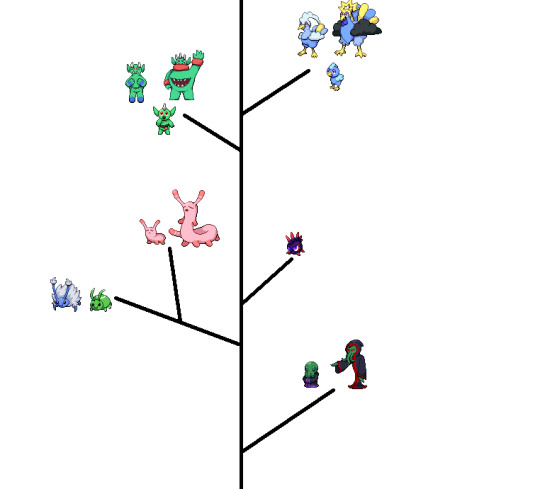
My first attempt attempt at a phylogenic tree for my fakemon. Its a little bare bones at the moment (mostly because I didn't include a lot of older fakemon i had because I'm not happy with their spriting) but i am happy with it! it also makes me want to diversify my fakemon basis’ because i have an awful lot of mammal and want to base things more on non-mammal creatures!
(Also if i did anything wrong lemme know because i'm definitely not 100% on a lot of these placements since i had to use wikipedia for help)
6 notes
·
View notes
Text
As someone with a lifelong love for animals esp. vertebrates esp. esp. mammals i sure didnt expect to develop microbiology special interest but here we are
#animals are still a sp int too#as evidenced by my enthusiasm last semester in my zoology class#did you know starfish are closer on the phylogenic tree to us than crabs#really you could say my special interest is biology no it isnt yes it is ♡#i am intinidated by organic chem bc i struggle with chem in general but hopefully ill improve after this fall course#im really nervous though!! lab work was what i was banking on for learning it but since remote learning is my college's plan i wont get that#that hands on experience#i just hope they can adapt online learning to lab learning well because last semester was a nightmare#watching dissections and doing them are VERY different and while it helps to watch a demonstration first i still need to do it to absorb it
4 notes
·
View notes